Opening date 1924 Catchment area 165 km² | Type of dam Concrete gravity Height 38 m Impound Little Rock Creek | |
 | ||
Owner(s) Palmdale Water DistrictLittlerock Creek Irrigation District Similar Lake Palmdale, San Dimas Dam, Sierra Madre Dam, Pyramid Dam, Bouquet Reservoir | ||
Little Rock Dam also known as Littlerock Dam, or officially as Little Rock-Palmdale Dam is a concrete gravity dam on Little Rock Creek in Los Angeles County, California, located about 5 mi (8.0 km) south of Palmdale. The dam and Little Rock Reservoir are owned by the Palmdale Water District and Littlerock Creek Irrigation District, and are used for agricultural and municipal water supply and flood control.
Map of Little Rock-Palmdale Dam, Littlerock, CA 93543, USA
The dam is 124 ft (38 m) high from foundation to crest and spans 576 ft (176 m) across the canyon, forming a reservoir with a capacity of 3,700 acre·ft (4,600,000 m3). The reservoir has a surface area of 108 acres (44 ha) and receives water from a drainage area of 63.7 sq mi (165 km2) on the north slope of the San Gabriel Mountains. A popular recreation spot, the dam, reservoir and vicinity receive about 300,000 visitors each year.
Designed by John S. Eastwood, a noted engineer of several dams in the western U.S., Littlerock was originally built in 1924 by the Palmdale Irrigation District (now Palmdale Water District) to provide a water supply for orchards in the area. With a height of 112 ft (34 m) and holding 2,400 acre·ft (3,000,000 m3) of water, it was the tallest multiple-arch reinforced concrete dam in the world at the time. The dam's design combined with its record height was highly controversial; the state mandated renovations in 1932, in which concrete buttresses were added to the dam face. In 1938, the dam nearly failed as a result of historic flooding, which led to the evacuation of hundreds of people in downstream towns. The dam was renovated again in 1966 to comply with increasing safety standards and regional urban development. In the 1970s, it was listed on the National Register of Historic Places (NRHP).
In 1994, the last major renovation of the dam was completed, which involved strengthening the face with roller-compacted concrete, hiding the original multiple arch design forever and transforming it to resemble a conventional gravity dam. The arches are still visible on the back face of the dam when the water level in the reservoir is low. The design changes resulted in the dam being taken off the NRHP. The dam was also raised 12 ft (3.7 m) and a new spillway added, increasing the reservoir capacity to its current 3,700 acre·ft (4,600,000 m3).
